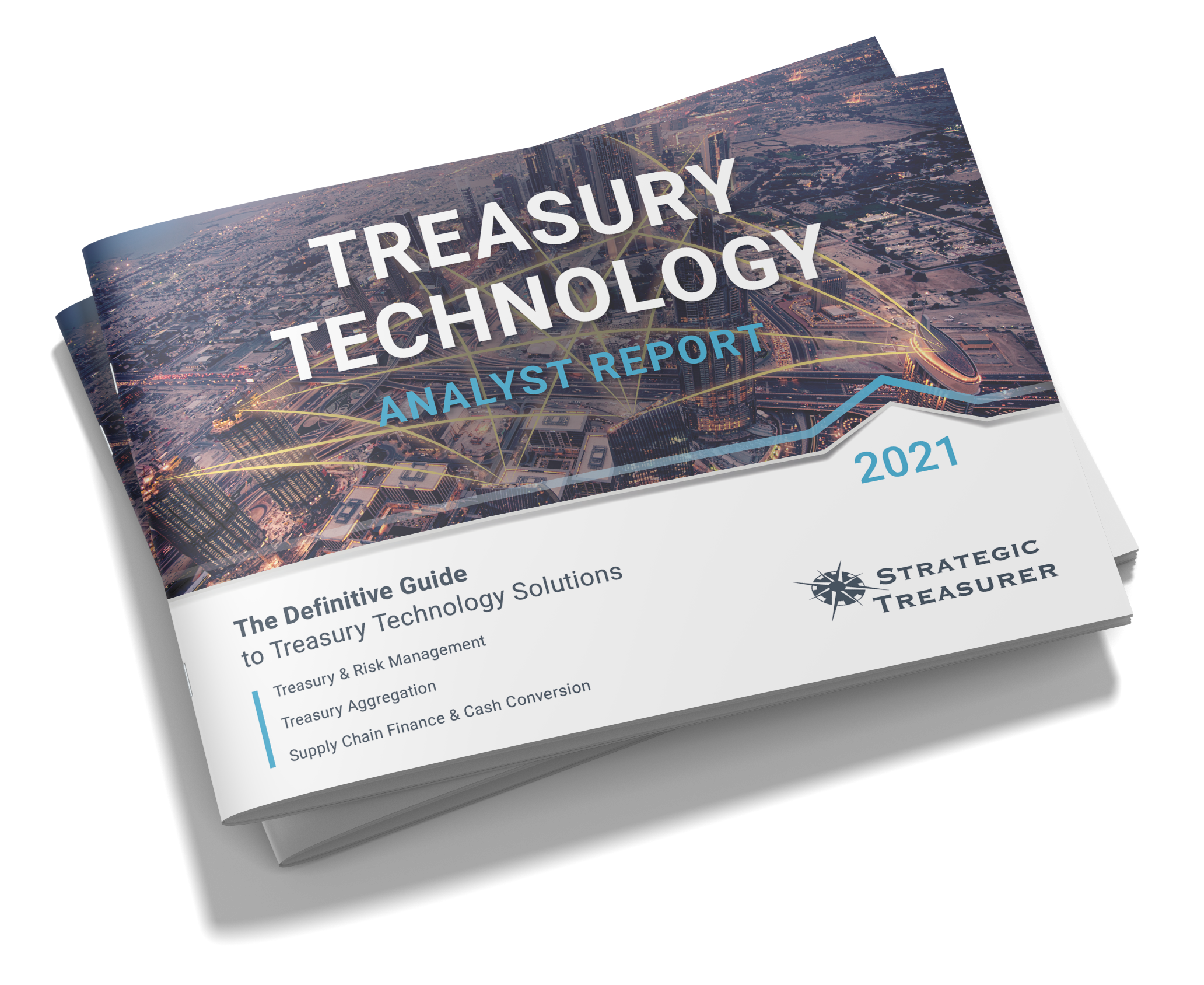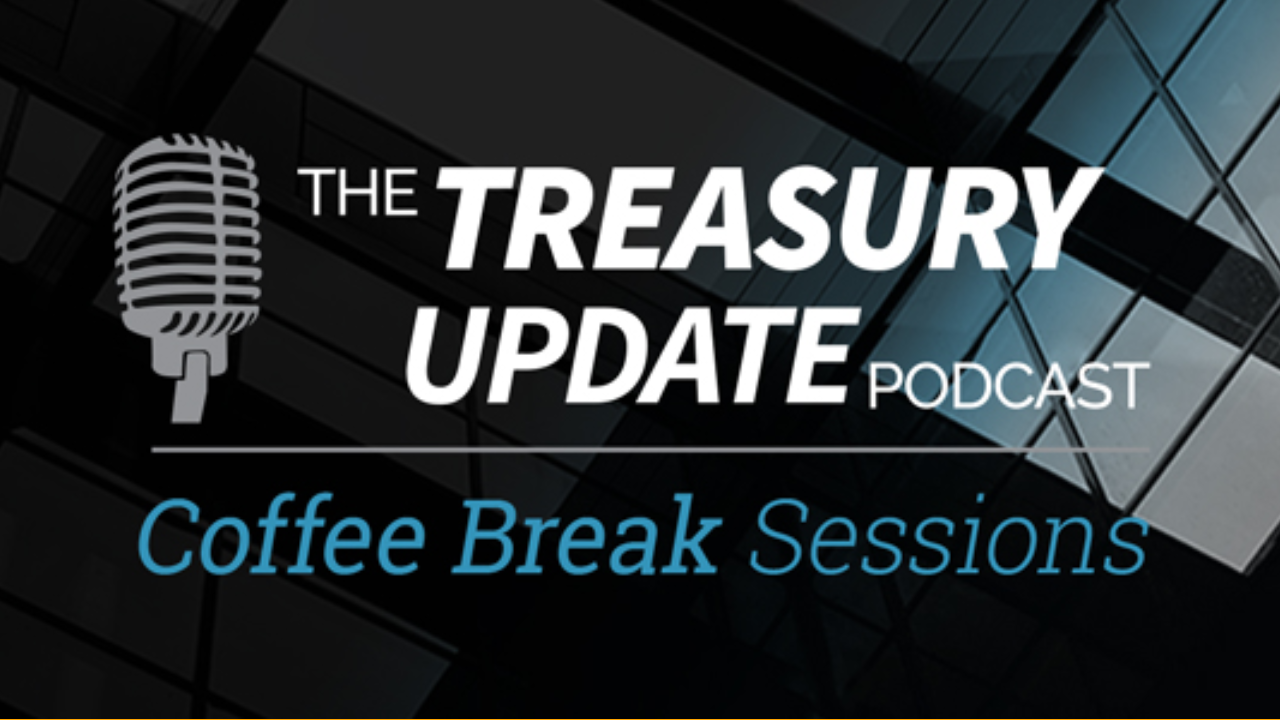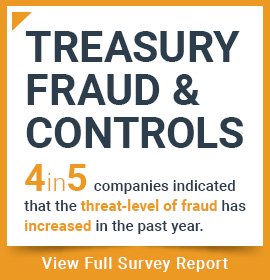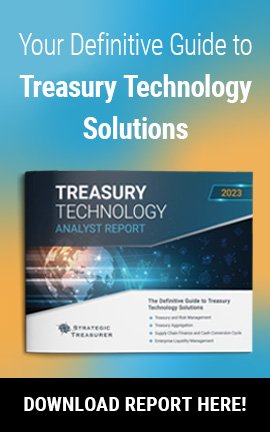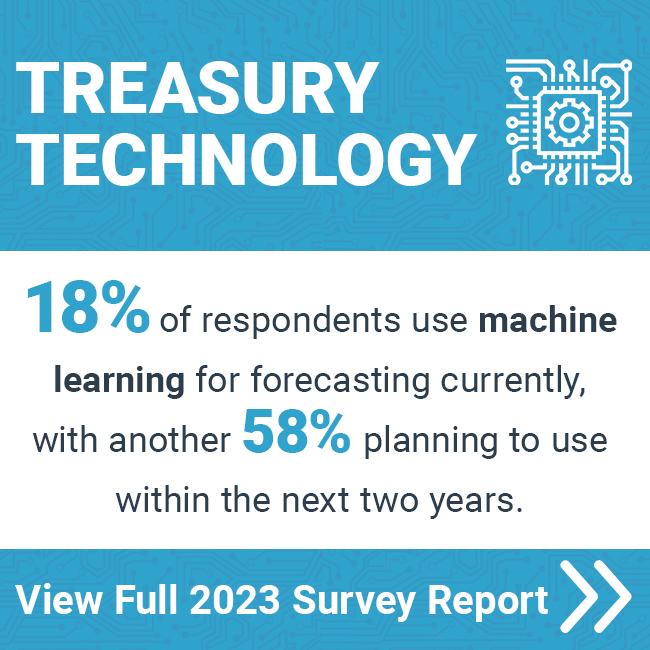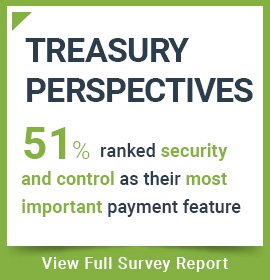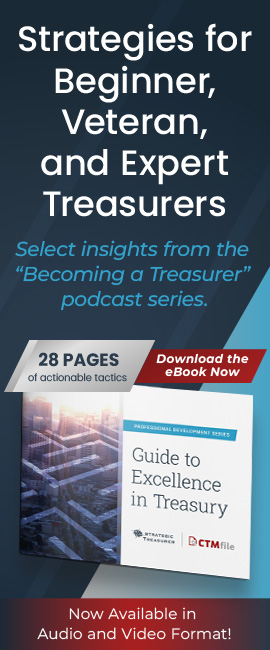
Episode 199
The Profitability of Securities Lending
In this episode, Craig Jeffery welcomes our newest Senior Consultant, Paul Galloway, to the team. This conversation centers around the must-know items regarding security lending and Paul’s previous experience in treasury. Listen in to find out more.
Host:
Craig Jeffery, Strategic Treasurer


Speaker:
Paul Galloway, Strategic Treasurer


Episode Transcription - Episode #199 - The Profitability of Securities Lending
Nicki Gillispie 0:01
Welcome to The Treasury Update Podcast presented by Strategic Treasurer, your source for interesting treasury news, analysis, and insights in your car, at the gym or wherever you decide to tune it.
Craig Jeffery 0:16
Welcome to The Treasury Update Podcast. This is Craig Jeffrey, and I am here today with Paul Galloway. Paul has joined Strategic Treasurer as our newest senior adviser. So, I’m welcoming him to the podcast and to Strategic Treasurer. Welcome, Paul.
Paul Galloway 0:32
Thank you, Craig.
Craig Jeffery 0:33
Paul, maybe you could begin telling us just a little bit about your background, so people know who’s talking to them.
Paul Galloway 0:40
Yeah, I’m a Midwest boy, born and raised in Des Moines, Iowa. I did my undergrad at Iowa State, graduate degree at Iowa. I hold the CFA charter and I have worked for a variety of companies within the Des Moines metro area. I’ve worked for a bank, an insurance company, a regulate utility, an Ag business I’ve consulted on my own. Most recently spent four and a half years in an insurance company standing up a treasury function for the company which didn’t exist before I came there.
Craig Jeffery 1:15
Excellent. So, today’s topic is security lending. I think it’ll be an interesting topic for anyone who’s interested in treasury, though it may not apply to people in every industry. So maybe you could start off by what is security lending or SEC lending. What is that? And then maybe we can get into why this occurs?
Paul Galloway 1:34
Sure, securities lending is what it sounds like. Companies have assets on their books, and they have an opportunity to get additional yield on the securities by lending them to counterparties that have an interest in holding those assets. And they’ll pay you a certain agreed upon rate for the use of those securities and typically, they’re used by broker dealers and hedge funds.
Craig Jeffery 2:04
So maybe give an example of several other types of securities that these types of assets that we would refer to as securities, what are some of these that would be lended?
Paul Galloway 2:13
Typically, its bonds and equities. So, you could do both fixed income instruments and marketable tradable equity. Stock are things that people were typically akeen to the NASDAQ are traded for on the New York Stock Exchange.
Craig Jeffery 2:32
You said that different types of firms like broker dealers, etc. may need to have some of these assets. So, why did they need to borrow them? Why don’t they just hold them? What’s the value and the rationale for doing this?
Paul Galloway 2:46
Yeah, they borrow them because hedge funds and broker dealers will enter into positions where there’ll be shorter security and they need that as collateral for a transaction that they’ve engaged in. Some of these securities are not readily available in the market so they can’t go out and buy them, but they can go to insurance companies or other corporate firms that hold securities on the books and borrow them versus go out in the market and find them or buy them.
Craig Jeffery 3:19
That’s why the borrower would borrow those securities for collateral. In that case, your giving example whether it’s a hedge fund or a broker dealer, what’s the reason for lending those beyond just the fact that there might be some margin because there’s obviously some potential exposure that the collateral gets sold?
Paul Galloway 3:39
Here there’s typically two reasons. One is the lender, or the securities is looking to enhance the yield or return on their portfolio. The other is that they want to take a certain level of risk in the lender securities and perhaps get bonds or cash or stock back and do something with them that could be riskier and try to get a return on that.
Craig Jeffery 4:08
So, from a lender or borrower perspective, what’s the other exposure if you’re if you’re lending securities, what is your biggest concern? How is that mitigated with duration or other with other techniques in the security lending arena?
Paul Galloway 4:25
So, the biggest concern is for me in my past experience has been reinvestment risk. Even though I’m lending the securities I have to pay a benchmark rate back to the counterparty that has borrowed it. It’s agreed upon upfront. It could be something like the overnight bank funding rate or something like that. And so that’s the bogey that I’m trying to beat. So, I take whatever the collateral is that comes back to me, and I invest that in a way that beats that return. And I keep everything that’s left, less the amount that I agreed upon with the intermediary or the bank, who’s the go between myself and the counterparty. I get to keep everything else now the other thing that can’t be risky securities lending before 2008 and 09 when things went–the Great Recession. Securities lending was a lot more risky because the intermediary wasn’t indemnified in the sense that if the security if you couldn’t get the security back that was on you, so there was a big risk associated with not getting the security back if the counterparty defaulted or went bankrupt, you couldn’t get it back. Well, the way agreements are written today, there’s an indemnification which states that the intermediary is required to go out in the open market and buy the bond back and replace it or buy a bond that is like what was lent or a stock.
Craig Jeffery 6:11
So, this intermediary has to earn their keep.
Paul Galloway 6:15
They do they gotta earn their keep, right? They can’t just sit back and just let it go. And they negotiate terms on your behalf. So, they’re looking to get the best deal because it’s in their interest. They get a piece of the cut. So, the better deals they negotiate the more that goes into their own pocket.
Craig Jeffery 6:34
I want to talk about the economics I know there’s going to be a lot of it depends on a number of factors the supply and demand for particular security. Some securities are readily available, and it’s purely an economic transactions. Others are very hard to come by and depending on where they’re at that can have an influence. What might organizations be looking at in terms of a spread in normal markets or dynamic markets? What are some of the ranges that you’ve seen? This is not prescriptive, or, you know, giving advice but what’s historically, where have you seen this this move that we’re talking several basis points? 100 basis points? What’s an investor who might consider securities lending? Who holds these what might they be looking at in different markets?
Paul Galloway 7:22
In normal markets, she could see spreads between five, ten maybe up to 20. It depends on what the target is. And it also depends on the security. For securities that are more readily available, or there’s opportunity to get them in the open market, counterparties gonna be less willing to pay a premium. So, you may get close to flat or close to target. No better. And then for securities that you can’t find out the market easily, or they’re just they’re not available period. They’re willing to pay much more for them. Because they are in a position that requires they had that particular piece of collateral and they don’t have it. So, they’re willing to pay up to get it. And so that could, you know, be 50, 100 basis points in a normal market, maybe a little bit more, depending on the security, abnormal markets such as when COVID hit, it could be hundreds of basis points to get the security on the books.
Craig Jeffery 8:32
Any other risks that you see from the lender side before we move on to the borrower side.
Paul Galloway 8:38
There are tax consequences. You got to think about how things were booked on your balance sheet. So, I think when you go into it, you need to look at the accounting aspects of securities lending. There are also regulatory things you have to consider. So, you can’t just look at the economics alone, and the risks you also need to look at the accounting and regulatory side of things.
Craig Jeffery 9:03
On the borrower side, what are some of the risks that you see? Maybe operationally or otherwise?
Paul Galloway 9:09
Yeah, on the borrower side, the lender can dictate how long they’re going to lend the security out. You can lend securities out overnight and roll them. You can lend them over an agreed upon stated term, which could be weeks, months in duration. And so, the borrower could lose out if the lender decided that they didn’t want to participate in the program anymore. Or if they sold the security and needed the security back. There is that aspect of the borrower can have the security today and it can be gone tomorrow, which could put them in a in a tough position.
Craig Jeffery 9:50
They don’t have the collateral that’s required for their other underlying financial transaction.
Paul Galloway 9:55
Exactly.
Craig Jeffery 9:57
So we think about securities lending who does this apply to you talk about hedge funds and broker dealers being borrowers of this and there’s others obviously, but who are some other borrowers and who does this make sense to enter this type of program? There’s obviously a fair amount of setup to get a program running. Maybe you could talk to that.
Paul Galloway 10:18
Yeah, there is a little bit of a setup to get the program up and running. I mean, you have to enter into agreements with the intermediary bank, and so there are some legal requirements that have to be completed. You need to put together as stated or set parameters around how the program will operationally function. You’ll have to work with your custodian who holds the assets. We set up in the case of the program I set up at the insurance company I was with I set up a separate custody account to move assets in and out as they were borrowed. You have to work with your investment accounting team in your investment operations team. You also need to put together investment guidelines. How is the collateral that’s received from the counterparty going to be invested? There are a lot of factors that go into just setting up the program. And then you have to monitor the program. The case of the program I had, I’m on the program every day. So, I always knew what my positions were. I always knew what was going on with the investment team. And from time to time we would have bonds that would be sold, and I’d have to get the bonds back. Or there could be involuntary calls on bonds. You have to replace collateral so there’s challenges to managing the program. So, you need to know how you’re going to do that upfront.
Craig Jeffery 11:58
Let’s say just talking about a transaction, you have a security that someone wants to borrow, you pass that over. They need that for their collateral, and what are they giving you in return for that in addition to a spread, what’s their collateral for your collateral?
Paul Galloway 12:15
So, there’s different ways you can run your program. You can receive cash, you can receive bonds, you can receive stock, you receive any kind of security that you set up in the guidelines as acceptable collateral. In the case of the program we had, it was cash. It was treasuries. It was certain government agencies, and it really wasn’t anything else. And for the most part, we ran a cash collateral only program because we took the funds, and we did something with them that we felt that we can be the benchmark rate and be able to earn a little bit of return and keep it relatively safe.
Craig Jeffery 13:03
And there are the spread or the fee on the collateral that you landed or this the securities that you lended. Who else does this apply to? Who could consider participate in in lending? Obviously have debt securities but would be typical players in this?
Paul Galloway 13:22
typical players could be insurance companies or quite often typical players but foundation’s, endowment funds, any institution that has securities sitting in a custody account, let’s just keep it that simple. We have securities sitting in a custody account, you can win those securities out. And so in reality, it can be agnostic to what type of entity you are.
Craig Jeffery 13:54
Would there be a guideline to say you need to have this much to make it worth setting up this type of program and running it like you’re not going to do it if you have a $1 million bonds, you’re gonna lend out.
Paul Galloway 14:06
Yeah, so the intermediaries are gonna look for institutions that have a lot of assets. So, we’re gonna be looking at billions of dollars. And what they’ll do is they’ll come in they’ll look at your portfolio and totality and they’ll share with you what they believe the counterparties would be interested in. But sort there’s certain securities that the power or just aren’t gonna want they’re gonna want particular bonds or stocks, because they don’t fit the parameters of what their needs are. So, they wouldn’t be lendable. So, it’s got to be a pool of lendable securities. And typically, it’s got to be sizable in order to make it operationally effective for the intermediary. Size does matter. And lendable securities matter.
Craig Jeffery 15:04
As we wrap up this discussion about securities lending, what’s the state of in favor out of favor of securities lending today? Pre financial crisis before 2008 Very popular, you know, there’s different risk parameters. fell very much out of favor, where is it today, particularly, pre pandemic post pandemic? I think we can say that now, what’s the overall status of the recent securities lending market?
Paul Galloway 15:32
Yeah, I think the SEC lending program or market in general, is still robust, and it’s a needed function within the markets. So, I don’t see SEC lending going away, especially post Great Recession. Pre-Great Recession there was the factor I talked about earlier with regards to identification. Without that, what was happening from the lender’s perspective, is they had a hard time getting their bonds back. And in many cases, they lost them. They literally weren’t able to recover the bonds. And so, they suffered losses that were significant. And that shut down a lot of securities lending programs, which was a big problem for broker dealers and hedge funds. Because they rely on those programs. When the intermediaries came together and said, “Hey, we got to change this.” It came down to the indemnification, which really helped bring back the SEC lending industry, for lack of a better term. I don’t know if it’s truly an industry but it’s a financial function that is needed and brought it back. COVID was definitely a blow from our perspective, we drew back on the program. Not everyone did that. But some folks did do that. But the programs that were in place, a lot of them kept going, they kept engaged in lending securities. So, it didn’t dry up completely. But it did slow down for a brief period, and I think it’s bounced back.
Craig Jeffery 17:16
So just to follow up, you talked about losing the bonds and so the organizations that were lending lost those particular bonds because they were pulled out of the process. But you would still maintain the company that may have lost those bonds that they lend it still had collateral that they then own. Is that proper?
Unknown Speaker 17:36
They did. They had collateral that they owned, which unfortunately during that period lost value. And so the sale of the collateral, if it was a cash, you know, they took a hit,
Craig Jeffery 17:51
Right, especially if it’s a bond and rates, rates shift or whatever fell out of favor?
Paul Galloway 17:56
Yep.
Craig Jeffery 17:57
So, it’s still collateralized the program, but it depends on the type of collateral you have. Right?
Paul Galloway 17:59
Exactly.
Craig Jeffery 18:04
Well, Paul any final words on security lending?
Paul Galloway 18:08
Anyone that is thinking or contemplating engaging in a securities lending program, make sure you do your homework. You need to look at the total program of what it’s going to take to stand it up. Work with your internal partners, legal, accounting, investment operations, other functions within the organization that a program would touch. You’ll have to put together a good rationale, a pitch book, for lack of better terms that describes what the program is and helps the senior management team understand what you’re going to engage in. For our program. I had to go to the board. So, the board had to approve it. And that may not be uncommon with many companies, that would be a requirement. So, there is a little bit of legwork to get the program stood up. Just make sure you do your homework.
Craig Jeffery 19:07
Excellent. Thank you so much, Paul, for joining me on today’s Treasury Update Podcast.
Paul Galloway 19:12
Thanks, Craig. Appreciate it.
OUTRO 19:16
You’ve reached the end of another episode of The Treasury Update podcast. Be sure to follow Strategic Treasurer on LinkedIn, just search for Strategic Treasurer. This podcast is provided for informational purposes only, and statements made by Strategic Treasurer LLC on this podcast, are not intended as legal, business, consulting, or tax advice. For more information, visit and bookmark strategictreasurer.com.
Subscribe to the Treasury Update Podcast on your favorite app!
Related Resources
Treasury Technology Analyst Report
Researching new treasury and finance technology can be overwhelming. Strategic Treasurer has stepped in to help. Explore our definitive guide to the treasury technology landscape and discover detailed, data-based coverage of each area.





